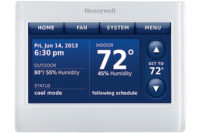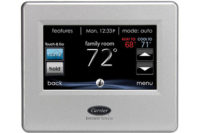NOW AVAILABLE, SOON REQUIRED
The 2010 R-22 phaseout deadline is an inevitability that the industry is preparing to embrace in multiple capacities. As commercial contractors, the installation and maintenance of rooftop units containing R-410A needs to be addressed as well.After examining the installation side of the issue, Ken Bodwell, CFO of Innovative Service Solutions, a mechanical contractor in Orlando, Fla., decided that the R-22 phaseout isn’t going to have any great effect on the day-to-day rigors of rooftop installation.
“This really should be no different than R-11 or R-12,” he pointed out. “In fact, we started making our clients aware of the phaseout early, and starting Jan. 1, 2008, we quoted every unit replacement with the option of R-22 or R-410A. I would say better than 50 percent of this year’s changeouts have chosen R-410A.”
What Bodwell is more concerned about is the maintenance challenge that is slowly presenting itself. He cautioned that the cost of R-22 is continuing to climb. “We can pass on the increase, but refrigerant margins are eroding,” he said. “Clients are looking at the escalating cost and are starting to question it.”
Russ Donnici, president of Mechanical Air Service Inc., San Jose, Calif., agreed with Bodwell’s observation that the phaseout was not going to be a real issue in regards to rooftop installations. “Our commercial clients are aware of the phaseout,” he said. “We have been selling units with R-410A for some time, if they are available in the size needed.”
When he observed the need for size availability, Donnici hit on a challenge that manufacturers are diligently addressing. The current HVACR manufacturing community already has multiple R-410A rooftop units on the market. Meeting the vast tonnage demands of the light commercial and commercial markets, however, takes time.
Skip Ernst, McQuay’s marketing manager for Applied Air Products, acknowledged the time investment that new R-410A products require. “We’ve been working on R-410A rooftop products for about a year,” he said. “What we have developed is two full rooftop lines - one for the commercial arena, and one that is better suited for custom installations.”
According to McQuay, the company now offers the broadest range of large R-410A rooftops in the industry, with capacities from 30 to 140 tons. All of these units are available with efficiencies that exceed ASHRAE 90.1-2010 requirements.
“With the new refrigerant, contractors will experience some changes in detail, but not in concept,” noted Ernst. “They will, however, have to use the proper gauges and refrigerant oils that are compatible with the higher pressures.”
Bodwell considers gauges to be a “small price” when discussing the necessary tools to successfully install and maintain R-410A rooftop units. “The real tool is education of the technicians,” he said.
With this in mind, Innovative Service Solutions has been inviting different representatives in to discuss the characteristics of refrigerants and their blends. The company has also initiated additional training on proper charging procedures. After discovering an issue with mixing refrigerant types, it began focusing its efforts on proper recovery into dedicated tanks.
“Right now we are looking at different racking systems to carry the different refrigerants and recovery tanks,” he explained. “Our trucks carry nine different refrigerants because we service a wide range of HVACR equipment for a wide range of purposes.”
Beyond gauges, tools, and new operating procedures, Ernst warned contractors to closely watch their future project dates.
“Buildings and projects being quoted now with R-22 systems will be illegal come the 2010 deadline time, which for many will be before the project is actually complete,” he cautioned. “When working on projects and designing buildings today, contractors need to think about the date that the product will actually ship.”
EASING THE REPLACEMENT MARKET
With the changing refrigerant requirements, the rooftop replacement market is edging upwards on the commercial contactor’s weekly checklist. After spending time studying the market, Bryant Heating & Cooling Systems found that when it came to rooftops, contractors were most satisfied when the footprint of the replacement unit was the same as the old unit.Taking into consideration this vital piece of information, Bryant requested that its engineers match the unit footprint of the mid 1980s while increasing the efficiency to 13 SEER. The result was the Legacy™ line rooftops with Puron®.
“Sometimes it isn’t what you do, it’s what you don’t do that makes a difference for the replacement market,” observed Ted Cherubin, Bryant’s marketing manager for Commercial Unitary Systems. “It may not sound exciting, but our new rooftop is the perfect replacement model.”
The company not only increased the efficiency, it also left much of the unit’s connection points in the same classic position as the mid 80s. Doing this allowed contractors to cut out some of the extra cost involved in installing replacement units. It also negated the need for roof curb adapters which, according to Bryant, was causing concern - either structural or aesthetic -among some contractors.
“When we talked to contractors, we found that it was these hidden costs that really hurt their profitability,” Cherubin pointed out. “To address this, we left the electrical, gas, and condensate connection points in the same place. The duct connections and locations match as well.”
Besides the technology used to drive and keep the units ideal for replacement, Bryant engineers also found ways to fit more factory-installed options into the unit, including air management devices such as enthalpy and dry bulb fully modulating fresh air economizers; return and supply air smoke detectors; disconnect switches; powered and nonpowered convenience outlets; and a new, full range of fan performance capabilities with belt-driven design.
“These are still simple packaged systems, but they are effective and reliable,” noted Cherubin.

Sidebar: All–Aluminum Microchannel Condensers
McQuay’s R-410A rooftop products are equipped with all-aluminum microchannel condenser coils that are constructed of extruded flat tubes, aluminum fins brazed between the adjoining tubes, and two aluminum refrigerant manifolds - all oven-brazed together. The fin arrangement protects the fins from common surface damage and the aluminum manifold construction eliminates galvanic corrosion. It is the extruded flat-tube technology, with many small flow channels arranged in a two-bypass configuration, that assists in reducing refrigerant demand. According to the manufacturer, these tubes provide better fluid-to-tube heat transfer than traditional round tubes, more heat transfer per square foot, and require less refrigerant charge per ton of cooling.Publication date:06/16/2008







